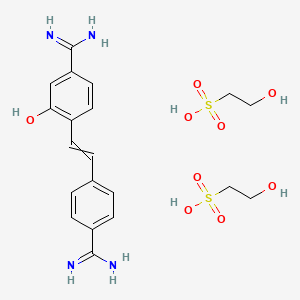|
Name: Chlorphentermine
Type: Appetite suppressant
AKA: Pre-Sate, Lucofen, Apsedon, Desopimon

|
|
II. Natural Derivative
Synthetic substance, no natural derivative
 |
|
III. Chemical Profile (IUPAC name)

|
|
IV. History
Chlorphentermine, a stimulant, was developed in the mid-20th century. It was used as an appetite suppressant in weight loss treatments but is associated with potential health risks and has been withdrawn from the market.

|
|
V. Legal Information
Chlorphentermine is a stimulant used as an appetite suppressant. It is controlled in the United States and other countries due to its potential for abuse and health risks. Regulations focus on limiting its use to prevent misuse and protect public health. [Source: UNODC].
US Federal Schedule - III
Schedule III drugs, substances, or chemicals are defined as drugs with a moderate to low potential for physical and psychological dependence. Schedule III drugs abuse potential is less than Schedule I and Schedule II drugs but more than Schedule IV. Some examples of Schedule III drugs are: products containing less than 90 milligrams of codeine per dosage unit (Tylenol with codeine), ketamine, anabolic steroids, testosterone.
Key US Federal Policies:
Controlled Substances Act. Public Law: Public Law 91-513 (text can be found on GovInfo) (https://www.dea.gov/drug-information/csa). Date enacted: October 27, 1970.
|
|
VI. Physical Effects
Chlorphentermine is a stimulant and appetite suppressant. It increases heart rate and blood pressure. Short-term use may aid in weight loss, but long-term use poses risks of cardiovascular issues, psychological problems, and dependency. Overdose risks include severe agitation and cardiovascular effects. Safe use requires careful dosing and monitoring. Recent research explores its efficacy in weight management and associated health risks.  |
|
VII. Psychological Effects
This stimulant has effects similar to other amphetamines, inducing euphoria and increased energy. Long-term use can lead to psychological issues like paranoia, aggression, and cognitive decline. Research focuses on its impact on neurotransmitter systems and potential for addiction.
 |
|
VIII. Culture
Chlorphentermine is a stimulant with appetite-suppressing properties, classifying it as an upper. Short-term use aids in weight loss and increases alertness, while long-term use can lead to cardiovascular issues and potential dependence. Overdose risks include severe agitation, cardiovascular complications, and potentially fatal outcomes. Safe dosages are typically under 40 mg per day. Recent research highlights its effectiveness in appetite suppression but warns of cardiovascular risks. Physical effects include increased heart rate, elevated blood pressure, and potential for severe agitation.
 |
